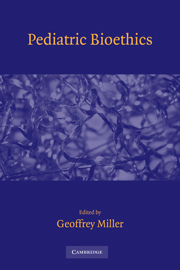Book contents
- Frontmatter
- Contents
- Contributors
- Preface
- A THE FOUNDATION: THEORY AND PRINCIPLES
- B GENETICS AND THE NEWBORN
- C THERAPIES
- 12 Rationality, Personhood, and Peter Singer on the Fate of Severely Impaired Infants
- 13 The Ethics of Controlling Reproduction in a Population with Mental Disabilities
- 14 Pediatric Innovative Surgery
- 15 Conjoined Twins
- 16 Ethics and Immunization
- 17 Psychotropic Drug Use in Children: The Case of Stimulants
- D END OF LIFE
- Index
17 - Psychotropic Drug Use in Children: The Case of Stimulants
Published online by Cambridge University Press: 07 May 2010
- Frontmatter
- Contents
- Contributors
- Preface
- A THE FOUNDATION: THEORY AND PRINCIPLES
- B GENETICS AND THE NEWBORN
- C THERAPIES
- 12 Rationality, Personhood, and Peter Singer on the Fate of Severely Impaired Infants
- 13 The Ethics of Controlling Reproduction in a Population with Mental Disabilities
- 14 Pediatric Innovative Surgery
- 15 Conjoined Twins
- 16 Ethics and Immunization
- 17 Psychotropic Drug Use in Children: The Case of Stimulants
- D END OF LIFE
- Index
Summary
INTRODUCTION
Rising rates of stimulant drug use among children have been accompanied by a vigorous social and ethical debate over the relative harm and benefits of psychotropic drugs for children. Of these drugs, the stimulants methyl phenidate (e.g., Ritalin) and amphetamine (e.g., Adderall) are the most frequently used. In a medical context, stimulants are almost always prescribed to treat attention deficit/hyperactivity disorder (ADHD); therefore, debates about stimulants have included concerns about the validity and overdiagnosis of ADHD. ADHD is the most common child psychiatric diagnosis in the world and is characterized by core symptoms of inattention, hyperactivity, and impulsiveness. Most children are first diagnosed when they reach school age; approximately 75% of those diagnosed are male.
The debate over ADHD and stimulant drugs is characterized by polemical positions that can misrepresent scientific understanding of ADHD, on the one hand, and dismiss valid social and ethical critiques of the disorder and drug treatment, on the other. This chapter encourages a balanced perspective. After a background section in which some of the controversies over ADHD and stimulant drug treatment are reviewed, the discussion will focus on the identification and analysis of key ethical issues that pediatricians and mental health care providers need to be aware of in order to provide the best care for young people and their families.
BACKGROUND CONTROVERSIES
Validity of ADHD Diagnosis
Two definitions are currently used in the diagnosis of ADHD. American psychiatry follows the ADHD diagnosis described in the Diagnostic and Statistical Manual of Mental Disorders, 4th ed. (DSM-IV). DSM describes two primary categories of behavioral symptoms: inattention and impulsivity-hyperactivity.
Keywords
- Type
- Chapter
- Information
- Pediatric Bioethics , pp. 231 - 244Publisher: Cambridge University PressPrint publication year: 2009

